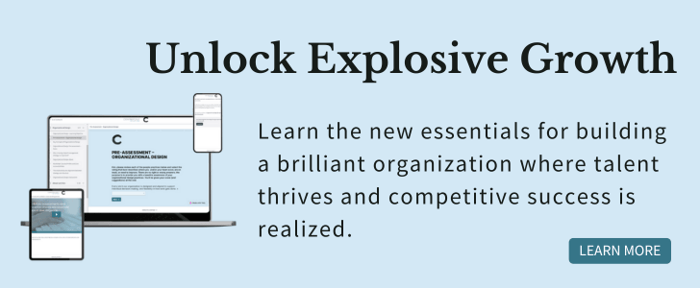The concept of a Talent Development Strategy may seem fundamental given the critical role people play in business success. Yet, it’s surprising how many small to mid-size organizations lack a well-crafted talent strategy that truly delivers on its promise or haven't adapted their approach to meet the evolving demands of today’s workplace.
In their recently released report, Engines of Growth, the Business Council of Canada makes a very clear case for small to mid-size enterprises (SME’s) to step up to their productivity challenges with a meaningful talent development strategy. In that report, they cite that 98% of all Canadian companies are SME’s and that too few of them are scaling up, and unproductive SME’s are unlikely to grow.
Planning for new positions and hiring externally is often a primary focus in growing organizations. But the next level - a robust talent development strategy - is devoted to increasing the value of the talent you currently have and the people practices in place to support them. When crafted well, the strategy embodies everything your organization does, at every level, to hire, onboard, integrate, upskill, reskill, reward, manage performance, and plan for succession. This can sound like a lot, especially for a small to mid-size business or non-profit organization, but when the strategy is built over time as your teams and business grow, it can be an invaluable lever in achieving the strategic intent of your business.
The talent development strategy isn’t just the purview of People and Culture experts, it’s a prime element of every leader’s management portfolio. Consider that most teams have in the past year hired and onboarded at least one new team member, or seen others promoted, reskilled, or exit the organization. Leaders must understand the full picture of their talent strategy to best manage these individual events as they unfold.
Let's look a bit deeper at the value it brings. Your company probably does a great job with its financial planning, forecasting and budgeting, and identifying both current and future cash flow needs. Regular financial reporting and analysis of trends and risks to the organization would be routine and expected. Similarly then, the same types of regular reviews, reporting, analysis and processes are needed to ensure the right talent resources are in place. The overall purpose of a talent strategy is to provide the business focus, planning and risk management for talent success, in the same way you do for financial success.
To continue the analogy to financial planning, every business knows that focusing only on past financial performance indicators while failing to forecast, to review cash flow, and to budget, will eventually experience a negative cash flow. Similarly, a business that only conducts performance appraisals to review past employee performance indicators, but fails to identify future talent needs, fails to address talent vacancy risks, fails to identify and develop successors, and fails to retain and develop future leaders, will eventually experience profound talent deficits, characterized by a negative talent flow.
A Talent Development Strategy creates the foundation for formalizing, without adding undue structure or rigidity, the supports needed to effectively orientate and onboard new hires, ensure performance expectations and role clarity exists, that feedback happens, both formally and informally, that development opportunities are created, and that the state of talent within the organization is regularly reviewed. Each of these processes or activities create in their sum, talent risk management for the organization. Regular talent review meetings at the senior levels are the cornerstone for evaluating, developing, and executing the Talent Development Strategy.
If you’re too busy launching a new product line, considering an acquisition, or actively engaged in any number of business priorities, while issues of talent strategy are managed off the corner of someone’s desk when time is available, or a hot button issue arises, the costs to your organization will expand in both short and long term. In the short term, highly skilled individuals may leave, and you may find it increasingly difficult to find top talent to replace them. Or, there may be conflicts and tensions that exist when individuals aren’t being properly recognized or development opportunities aren’t happening.
Consider the example of a safety coordinator who focuses on investigating and writing up workplace accidents and safety violations, rather than identifying the funds and processes that are needed to provide safety training and put safety procedures in place. In this case, a lack of strategy and the corresponding costs of “ambulance chasing” the safety function are enormous and can lead to significant employee turnover and the costs of employee absences due to workplace injuries.
Similarly, consider the concept of “benchstrength”; most leader/managers know its importance when it comes to competing effectively and sustaining success over the long term. But the steps and processes for creating that benchstrength may well be fragmented, an afterthought, executed reactively or too late. A Talent Development Strategy makes explicit the talent agenda and what leaders and managers need to be accountable for to ensure the right people are in the right places at the right time.
More and more business owners are realizing that the knowledge, innovative ideas, and skills of their people are increasingly the most important competitive advantage for the business. Don’t leave this competitive advantage to chance. The best organizations review business decisions and talent decisions as one and are more likely to ensure their talent and business strategies are tightly aligned.
Looking for the steps to creating your talent strategy?
Consider online learning with Align. Grow. Prosper: Meeting the Talent Challenges of a Changing Workplace. You can learn more here.





